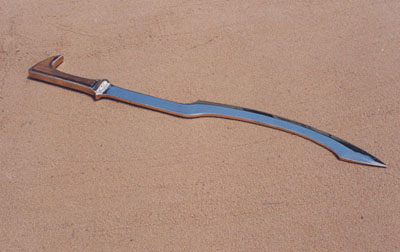http://www.manningimperial.com/item.php?item_...group_id=1
I'd been wanting a Khopesh for the longest time. Sadly, nobody made any, for the longest time. A while back I visited Manning Imperial's website, where they had an "Egyptian Chopper" for sale. I thought it was nice, and I would put it on my list. But it wasn't quite what I wanted from a Khopesh (it was a bit wide and "chunky" looking). Well, more recently I revisited the Manning Imperial site and, lo and behold, there it was -- a "Canaanite Sword" -- in other words, a khopesh similar to that which I'd been looking for! And not only did they have it illustrated on their site, but they had one in stock!
The Khopesh seems to have been a fairly common edged weapon of the bronze-age middle east. As it's design indicates, it is a single-edged sword meant for slashing or hacking, almost like an axe. The Manning Imperial sword seems to be partially based on a "sickle sword" pictured in the Osprey/Men-At-Arms book Ancient Armies of the Middle East by Terence Wise, on page 23. This particular sword is dated from 1570-1200 BC, and the caption says that the Egyptians possibly learned how to make the Khopesh from the Canaanites. There are other Khopesh swords of similar appearance and dimensions; one of the best known was found in Tutankhamun's tomb.
I wish I could tell you how the replica compares with an original; alas, I don't really know as I've never handled an original. But I can give my impressions of this reproduction....
Here are some numbers:
OA Length: 25.5 inches
Blade length: 19.5 inches
Hilt length: 6 inches
Grippable length: about 4.25 inches
Blade width (at ricasso): 1 inch (it gets up to 1.5 inches at the widest points, at the base of the curve and toward the tip of the curve)
Weight: 2 lbs, 10 oz.
PoB/CoG: 3.5 inches
CoP: Don't know. Can't measure it with any certainty. The sword is very stiff, it transmits very little vibration. I'm thinking either that the curve may be one big "sweet spot", or that it's near the middle of the curve (about 12 or 13 inches). Both those are SWAGs, however.
Appearance wise, it's not the fanciest khopesh I've ever seen, but there aren't too many real "fancy" ones actually available. It was obviously cast from a bright, shiny bronze -- there are little "casting defects" such as rough spots and "bubble pits" at various points on the blade. The blade is sharpened on the curve and for a little bit on the back edge. The grip is fairly comfortable, large enough for someone with fairly large hands. The "grip tongue" has been fitted with some kind of light-colored wood; I don't know what kind nor how it got stuck there.
The weight is okay. It is not as heavy as the Del Tin bronze clunkers nor is it as light as a Bronze-Age Foundry sword. The balance is nice. It feels like you could smite Canaanites, Jebusites, Amorites, Moabites, Hittites, and other-ites most effectively. The length seems to be in keeping with most khopesh (they seem to vary around 20 to 25 inches in length. The "King Tut Adult sword" is about 23.5 inches long (FYI, there was also a much smaller khopesh found in Tut's tomb, about 15 inches total length, quite possibly something from his not-too-distant youth)). There is no distal taper worth noting (did the original khopeshes have DT? Does anyone know?).
Anyway, I'm quite content with the Manning Imperial Canaanite Sword. It's definitely different, and a decent replica of an important piece in the history and development of the sword -- and of the early peoples who helped shape the foundations of the modern world.
